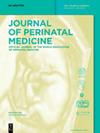The effect of uterine closure technique on cesarean scar niche development after multiple cesarean deliveries
IF 1.7
4区 医学
Q3 OBSTETRICS & GYNECOLOGY
引用次数: 0
Abstract
Objectives To use saline infusion sonohysterography (SIS) to evaluate the effect of uterine closure technique on niche formation after multiple cesarean deliveries (CDs). Methods Patients with at least one prior CD were evaluated for niche via SIS. Subgroups of any number repeat CD (>1 prior), lower-order CD (<4 prior), and higher-order CD (≥4 prior) were analyzed, stratifying by hysterotomy closure technique at last cesarean preceding imaging; techniques included Technique A (endometrium-free double-layer closure) and Technique B (single- or double-layer routine endo-myometrial closure). Niche defects were quantified (depth, length, width, and residual myometrial thickness). The primary outcome was clinically significant niche, defined as depth >2 mm. Statistical analysis was performed using chi-square, ANOVA, t-test, Kruskal-Wallis, and multiple logistic regression, with p-values of <0.05 were statistically significant. Results A total of 172 post-cesarean SIS studies were reviewed: 105 after repeat CDs, 131 after lower-order CDs, and 41 after higher-order CDs. Technique A was associated with a shorter interval to imaging and more double-layer closures. Technique B was associated with more clinically significant niches across all subgroups, and these niches were significantly longer and deeper when present. Multiple logistic regression demonstrated a 5.6, 8.1, and 11-fold increased adjusted odds of clinically significant niche following Technique B closure in the repeat CD (p<0.01), lower-order CD (p<0.001), and higher-order CD (p=0.04) groups, respectively. Conclusions While multiple CDs are known to increase risk for niche defects and their sequelae, hysterotomy closure technique may help to reduce niche development and severity.子宫闭合技术对多次剖宫产后剖宫产瘢痕龛发育的影响
目的 使用生理盐水输注超声造影(SIS)评估子宫闭合技术对多次剖宫产(CD)后子宫龛形成的影响。方法 通过 SIS 对至少有过一次剖宫产的患者进行子宫龛影评估。根据造影前最后一次剖宫产时的宫腔闭合技术进行分层,分析了任意次数重复剖宫产(1次)、低阶剖宫产(4次)和高阶剖宫产(≥4次)的亚组;技术包括技术A(无子宫内膜双层闭合)和技术B(单层或双层常规子宫内膜闭合)。壁龛缺损被量化(深度、长度、宽度和残余子宫肌层厚度)。主要结果是有临床意义的壁龛,定义为深度为 2 毫米。统计分析采用卡方检验、方差分析、t检验、Kruskal-Wallis检验和多元逻辑回归,P值在<0.05时具有统计学意义。结果 共回顾了 172 项剖宫产后 SIS 研究:其中 105 例为重复 CD 后,131 例为低阶 CD 后,41 例为高阶 CD 后。技术 A 与更短的成像间隔和更多的双层闭合有关。在所有分组中,技术 B 与更多具有临床意义的龛影有关,而且这些龛影明显更长、更深。多重逻辑回归显示,在重复 CD 组(p<0.01)、低阶 CD 组(p<0.001)和高阶 CD 组(p=0.04)中,技术 B 闭合后出现有临床意义龛影的调整后几率分别增加了 5.6 倍、8.1 倍和 11 倍。结论 众所周知,多次 CD 会增加龛影缺损及其后遗症的风险,但子宫切开闭合技术可能有助于减少龛影的发展和严重程度。
本文章由计算机程序翻译,如有差异,请以英文原文为准。
求助全文
约1分钟内获得全文
求助全文
来源期刊

Journal of Perinatal Medicine
医学-妇产科学
CiteScore
4.40
自引率
8.30%
发文量
183
审稿时长
4-8 weeks
期刊介绍:
The Journal of Perinatal Medicine (JPM) is a truly international forum covering the entire field of perinatal medicine. It is an essential news source for all those obstetricians, neonatologists, perinatologists and allied health professionals who wish to keep abreast of progress in perinatal and related research. Ahead-of-print publishing ensures fastest possible knowledge transfer. The Journal provides statements on themes of topical interest as well as information and different views on controversial topics. It also informs about the academic, organisational and political aims and objectives of the World Association of Perinatal Medicine.
 求助内容:
求助内容: 应助结果提醒方式:
应助结果提醒方式:


